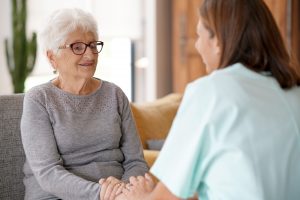Life After a Stroke: How to Live Without Fear
|
Reading time: 6 minutes
|

Serious heart-related illnesses make up a large majority of deaths per year; according to the CDC, approximately 647,000 Americans are killed due to heart disease every year.
Strokes are common in many individuals nowadays, and the idea of life after a stroke can be scary. How can you cope, and what are some ways to prevent another stroke from occurring?
Here is some great advice for living after a stroke and how to keep yourself safe and healthy.
What Is a Stroke?
A stroke is one of several types of brain injuries. It is often caused by blood not flowing properly to the brain, though there are several types of strokes. These include:
- Ischemic Stroke, the type mentioned above
- Hemorrhagic Stroke, where a blood vessel in the brain bursts and creates a bleed in the brain
- Transient Ischemic Attack (TIA), also known as a “mini-stroke”, which is often a sign of a larger level stroke happening later on
Any type of stroke can be extremely harmful, as the lack of oxygen flowing to the brain can cause cell death and harm to the rest of the body. Even TIAs should be treated just as seriously as a full stroke since they can still cause damage to the brain.
While strokes are more common in the elderly, anyone can have a stroke.
How is a Stroke Diagnosed?
There are certain symptoms and warning signs that can be used to tell if someone is having a stroke. The FAST test is a great way to figure out if someone may be experiencing a stroke. This involves:
- Face- check to see if there is any drooping, numbness, or difficulty moving parts of the face
- Arms- have the individual lift both arms. If one is lower than the other, or can’t be raised at all, that’s a sign of a stroke
- Speech- have the individual repeat a simple sentence. Are they stumbling over their words or slurring their speech? That may be a sign that they are having a stroke.
- Time- if you’ve noticed any of the above symptoms, you should immediately record the time that the event started. This will help doctors when they get on scene, as it will give them an idea of how much damage the person may have in their brain.
While these are great ways to tell if someone is having a stroke, there are other signs, including difficulty walking in a straight line, sudden headaches, or having issues getting one or both eyes to focus.
If you or someone near you is experiencing any of these symptoms, call 911 IMMEDIATELY for assistance.
Ways to Treat/Prevent Strokes
While there aren’t any specific medications to treat a stroke after it has happened, there are ways that you can prevent a stroke from occurring. If you have reason to believe that you or someone you know might be at risk of having a stroke, here are a few things that you can do to decrease your risk.
Exercise Regularly
Getting a good amount of exercise on a regular basis is a great way to break up fat in the body. By keeping your body healthy and active, you can prevent blood clots that could cause a stroke.
Exercising can also keep your blood pressure down, which also helps to prevent hemorrhagic strokes.
If you have already had a stroke and are trying to prevent another from occurring, talk with your doctor about the best exercises for you.
Eat a Healthy Diet
By cutting sugary foods and drinks out of your diet, you can keep your body healthy and prevent strokes. This is because the sugar you eat is likely to form clots in your blood vessels, which could lead to a stroke or other heart-related problem later on.
Try to consume foods that are low-fat and high-fiber to help you lower your risk of a stroke.
Avoid Alcohol and Other Dangerous Substances
Drinking alcohol can lead to higher blood pressure, which increases your risk of stroke; meanwhile, smoking can cause your arteries and blood vessels to shrink, which makes clotting more likely. Cutting down on smoking and drinking can dramatically decrease your risk of a stroke, along with other serious illnesses.
Take Medications to Lower Blood Pressure
Certain medications can also help to lower blood pressure and lessen your risk of stroke. Cozaar is one great medication that you can try for yourself.
Cozaar is a prescription medication that is used to lower the risk of stroke, diabetes, and other serious illnesses in certain people. If you have high blood pressure and want to fix it, talk to your doctor about a Cozaar prescription today!
Living Life After a Stroke
If you have suffered a stroke, or are worried that you might, it’s ok- there are plenty of people who have survived strokes and continued their lives after without much change. Between rehab and medications that can help you maintain a healthy lifestyle, you can get back to how you were before the stroke.
Rehabilitation Process: What to Expect
While you may be unable to do everything that you could before experiencing a stroke, rehabilitation is meant to get you back to an active lifestyle after such an event.
For strokes with minor brain cell damage, something as simple as a pamphlet to help you control your risk for additional strokes and exercises to help you regain muscle control may be all you need. This will especially be true for mini-strokes to help prevent a major stroke from happening in the future.
For major strokes, additional physical therapy and rehabilitation may be necessary to regain muscle control. Depending on the severity of the loss of muscle control, the patient may need to have continued support and rehabilitation for months or even years after the initial stroke.
The rehabilitation process helps to give patients a sense of control over their bodies again and get them back to independent living.
A Stroke Isn’t the End
Life after a stroke doesn’t have to be scary. With proper care and attention, you can go back to living life with only a few setbacks!
Do you have other questions about life after a stroke, Covaar, or other prescription medications to help you?
We can help! Read our FAQ page for additional information, and contact us with any questions that you might have afterward.
Information provided on this website is for general purposes only. It is not intended to take the place of advice from your practitioner







